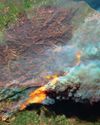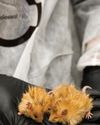From the PLEISTOCENE
Muse Science Magazine for Kids
|April 2022
The lost world of mammoths, saber-toothed cats, and dire wolves

Los Angeles, California, is one of the world's most glamorous places. Movie stars and fashion models, musicians and superstar athletes can usually be found under the bright lights of the bustling, sprawling city. But right in the middle of this glitz and glamour is a relic left over from a prehistoric world when strange creatures still roamed the Earth.
The pits at La Brea bubble with tar-in a busy urban park! For tens of thousands of years, the La Brea Tar Pits trapped animals big and small, becoming a graveyard for creatures of a lost age. Over time, the tar pits have become a treasure trove of bones. Today, the vast collection at La Brea helps scientists unravel the mysteries of an ancient world.
The Age of Giant Beasts
Most of the fossils recovered from the La Brea Tar Pits date back to the Pleistocene Epoch, a period that began about 2.6 million years ago and ended around 11,700 years ago. During the Pleistocene, the world was a much different place. Ice ages came and went. Glaciers helped carve out many of the mountains and plains, rivers and lakes that we see today.
By the time the Pleistocene began, dinosaurs had been extinct for more than 60 million years. Mammals now ruled the planet-very, very big mammals! The Pleistocene was dominated by megafauna, a word that literally means "large animals." Megafauna such as mammoths, mastodons, giant ground sloths, and short-faced bears roamed the lands that would one day be called North America.

Diese Geschichte stammt aus der April 2022-Ausgabe von Muse Science Magazine for Kids.
Abonnieren Sie Magzter GOLD, um auf Tausende kuratierter Premium-Geschichten und über 9.000 Zeitschriften und Zeitungen zuzugreifen.
Sie sind bereits Abonnent? Anmelden
WEITERE GESCHICHTEN VON Muse Science Magazine for Kids

Muse Science Magazine for Kids
ANIMAL FIREFIGHTER TO THE RESCUE
Can animals help manage the risks of deadly wildfires?
3 mins
Muse July 2025: The Story Behind Wildfires

Muse Science Magazine for Kids
FIRE DANGER
WHY THE RISK OF WILDFIRES KEEPS GROWING
4 mins
Muse July 2025: The Story Behind Wildfires

Muse Science Magazine for Kids
The Miller NEW Normal
WHAT TODAY’S WILDFIRES TELL US ABOUT OUR FUTURE
8 mins
Muse July 2025: The Story Behind Wildfires

Muse Science Magazine for Kids
WOMEN AND FIREFIGHTING: A GOOD FIT
Jessica Gardetto is a firefighter. Her father was, too. “I grew up with my dad coming home smelling like wildfire and covered in soot,” she says.
1 min
Muse July 2025: The Story Behind Wildfires

Muse Science Magazine for Kids
What is happening on your fingertips when they get all wrinkly in a hot tub?
—Felix G., age 10, Montana
1 mins
Muse July 2025: The Story Behind Wildfires

Muse Science Magazine for Kids
WHEN the SMOKE CLEARS
THE LINGERING EFFECTS OF THE RECENT PACIFIC PALISADES AND ALTADENA EATON FIRES
6 mins
Muse July 2025: The Story Behind Wildfires

Muse Science Magazine for Kids
PICKING TEAMS
Keep it fair with a strategy that relies on geometry.
2 mins
Muse July 2025: The Story Behind Wildfires

Muse Science Magazine for Kids
SHAN CAMMACK
WILDLIFE BIOLOGIST AND FIRE SAFETY OFFICER
3 mins
Muse July 2025: The Story Behind Wildfires

Muse Science Magazine for Kids
Scientists Create Mice With Woolly Mammoth-Like Fur
RESEARCHERS AT A COMPANY IN TEXAS ARE WORKING TO CREATE A LIVING ANIMAL THAT RESEMBLES THE EXTINCT WOOLLY MAMMOTH. Recently, they produced mice with traits of the large mammal. The mice all have coats with mammoth-like fur, and some of the small mammals also have genes that help them store fat. Both features would help the animals survive in the cold Arctic, where the woolly mammoth once lived.
1 min
Muse July 2025: The Story Behind Wildfires

Muse Science Magazine for Kids
Cool Sunshade Added to the Nancy Roman Space Telescope
THE NANCY ROMAN SPACE TELESCOPE IS A NEW TELESCOPE THAT NASA IS BUILDING AND WILL LAUNCH INTO SPACE, LIKELY IN EARLY 2027.
1 min
Muse July 2025: The Story Behind Wildfires
Translate
Change font size

